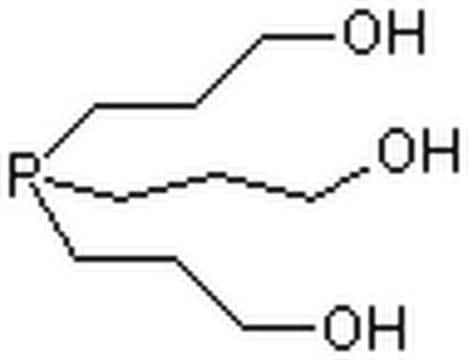68957
Tris(2-carboxyethyl)phosphine hydrochloride
BioUltra, suitable for electrophoresis, SDS-PAGE tested
Synonym(s):
TCEP.HCL, TCEP
Sign Into View Organizational & Contract Pricing
All Photos(1)
About This Item
Empirical Formula (Hill Notation):
C9H15O6P · HCl
CAS Number:
Molecular Weight:
286.65
Beilstein:
3724376
MDL number:
UNSPSC Code:
12352128
PubChem Substance ID:
NACRES:
NA.32
Recommended Products
product line
BioUltra
Quality Level
Assay
97.5-102.5%
form
powder
technique(s)
electrophoresis: suitable
solubility
H2O: soluble
suitability
SDS-PAGE tested
SMILES string
Cl[H].OC(=O)CCP(CCC(O)=O)CCC(O)=O
InChI
1S/C9H15O6P.ClH/c10-7(11)1-4-16(5-2-8(12)13)6-3-9(14)15;/h1-6H2,(H,10,11)(H,12,13)(H,14,15);1H
InChI key
PBVAJRFEEOIAGW-UHFFFAOYSA-N
Looking for similar products? Visit Product Comparison Guide
General description
Tris(2-carboxyethyl) phosphine hydrochloride (TCEP.HCL ) is a useful reducing agent for Sulphur and nitrogen-containing compounds. TCEP.HCL and the resultant oxide are water-soluble. TCEP.HCL has electron-rich phosphorus and oxygen atoms to combine with various metals, including Rh, Ir, and Pd. It rapidly complexes with Rh and Ir in dioxane at ambient temperature. It reduces disulfide linkages in a range of peptides and proteins in biological disulfide.
Application
TCEP.HCL has been used in various bioconjugation applications, both in vitro and in vivo, to tag proteins and live organisms with great effectiveness under mild physiological circumstances. TCEP.HCL is suitable for varied biological and synthetic applications. At an acidic pH, TCEP.HCL can be used to convert organic disulfides to thiols in water irreversibly.
Water soluble reagent, used for selective reduction of disulfides. More stable than DTT and useful in mass spectrometry applications.
Features and Benefits
The product has the following benefits:
- TCEP.HCL lowers reactive oxygen species levels.
- It increases glutathione levels and mitochondrial content.
- It has anti-cancer effects.
Analysis Note
agarose gel electrophorese corresponds to requirements
Signal Word
Danger
Hazard Statements
Precautionary Statements
Hazard Classifications
Eye Dam. 1 - Skin Corr. 1B
Storage Class Code
8A - Combustible corrosive hazardous materials
WGK
WGK 1
Choose from one of the most recent versions:
Already Own This Product?
Find documentation for the products that you have recently purchased in the Document Library.
Customers Also Viewed
Christopher R Schlieve et al.
Experimental eye research, 83(5), 1252-1259 (2006-08-29)
Retinal ganglion cells (RGCs) undergo apoptosis after axonal injury, in part regulated by an intracellular superoxide anion burst, for which the target(s) are unknown. Shifting the RGC redox state towards reduction and preventing sulfhydryl oxidation is neuroprotective in vitro and
Yiren Zeng et al.
Theriogenology, 162, 32-41 (2021-01-15)
Oocyte in vitro maturation (IVM) is a crucial process that determines subsequent in vitro embryo production. The present study investigated the effects of the antioxidant tris (2-carboxyethyl) phosphine hydrochloride (TCEP-HCL) on the in vitro maturation of porcine oocytes and in vitro developmental competence of
W H Fischer et al.
Rapid communications in mass spectrometry : RCM, 7(3), 225-228 (1993-03-01)
The suitability of the hydrochloride salt of tris(2-carboxyethyl)phosphine (TCEP) for in situ reduction with matrix-assisted laser desorption/ionization (MALDI) and liquid secondary ionization (LSI) mass spectrometry is evaluated. TCEP can be used to irreversibly reduce organic disulfides to thiols in water
Siming Chen et al.
Chemical communications (Cambridge, England), 49(12), 1226-1228 (2013-01-05)
A widely used reducing agent tris-(2-carboxyethyl) phosphine significantly promotes the reaction of cisplatin with Sp1 zinc finger protein. This discovery clarifies the reactivity of cisplatin towards Sp1 zinc finger protein and implies that the reactions of platinum drugs could be
Fang-Fang Cheng et al.
The Analyst, 139(16), 3860-3865 (2014-07-01)
The expression of microRNAs (miRNAs) is related to some cancer diseases. Recently, miRNAs have emerged as new candidate diagnostic and prognostic biomarkers for detecting a wide variety of cancers. Due to low levels, short sequences and high sequence homology among
Our team of scientists has experience in all areas of research including Life Science, Material Science, Chemical Synthesis, Chromatography, Analytical and many others.
Contact Technical Service









